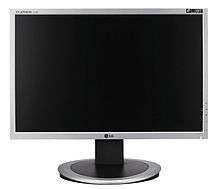16:10 aspect ratio
16:10 (8:5) is an aspect ratio mostly used for computer displays and tablet computers. The width of the display is 1.6 times its height. This ratio is close to the golden ratio "" which is approximately 1.618.

History
Computer displays
LCD computer displays using the 16:10 ratio started to appear in the mass market from 2003. By 2008, 16:10 had become the most common aspect ratio for LCD monitors and laptop displays.[1] Since 2010, however, 16:9 has become the mainstream standard, driven by the 1080p standard for high definition television and lower manufacturing costs.[2][3]
| 16:10 vs. 16:9 | |
1.6:1 (16:10) |
1.77:1 or 1.78:1 (16:9) HD video standard |
Industry moves towards 16:10 from 2003 to 2008
Until about 2003, most computer monitors had a 4:3 aspect ratio and some had 5:4. Between 2003 and 2006, monitors with 16:10 aspect ratios became commonly available, first in laptops and later also in standalone monitors. Such displays were considered to be better suited for productive uses such as word processing and computer-aided design.[4][5]
In 2005–2008, 16:10 overtook 4:3 as the most sold aspect ratio for LCD monitors. At the time, 16:10 also had 90% of the notebook market and was the most commonly used aspect ratio for laptops.[2] However, 16:10 had a short reign as the most common aspect ratio.
Industry moves towards 16:9 from 2008
Around 2008–2010, there was a rapid shift by computer display manufacturers to the 16:9 aspect ratio and by 2011 16:10 had almost disappeared from new mass market products. According to Net Applications, by October 2012 the market share of 16:10 displays had dropped to less than 23 percent.[6]
The primary reason for this move was considered to be production efficiency[3][7] - since display panels for TVs use the 16:9 aspect ratio, it became more efficient for display manufacturers to produce computer display panels in the same aspect ratio as well.[8] A 2008 report by DisplaySearch also cited a number of other reasons, including the ability for PC and monitor manufacturers to expand their product ranges by offering products with wider screens and higher resolutions, helping consumers to adopt such products more easily and "stimulating the growth of the notebook PC and LCD monitor market".[2]
The shift from 16:10 to 16:9 was met with a mixed response. The lower cost of 16:9 computer displays, along with their suitability for gaming and movies and the convenience of having the same aspect ratio in different devices, was seen as a positive.[3][9] On the other hand, there was criticism towards the lack of vertical screen real estate when compared to 16:10 displays of the same screen diagonal.[9][10] For this reason, some considered 16:9 displays less suitable for productivity-oriented tasks, such as editing documents or spreadsheets and using design or engineering applications, which are mostly designed for taller, rather than wider screens.[9][11][12]
Increase in number of high end laptops with taller aspect ratio
In 2020, Apple and Dell have released high-end productivity laptops with the 16:10 aspect ratio, while Microsoft has launched a new version of its 3:2 Surface Book. This year's version of the Dell XPS is the first that moves away from the classic 16:9 aspect ratio. Other brands have also adopted taller aspect ratios: Acer Swift 3, LG Gram, Asus ProArt StudioBook, have 16:10 ratio. [13]
Tablets
Tablets started to enjoy mainstream popularity beginning late 2010/early 2011 and remain popular to present day. Aspect ratios for tablets typically include 16:10, 16:9 and 4:3. Tablets have caused a shift in production away from purely 16:9 aspect ratios, and a resurgence of "productivity" aspect ratios (including 16:10 and 4:3) in place of "media" aspect ratios (16:9 and ultra wide screen formats). 16:9 is less suited for laptops, PC monitors and tablets. The format remains widely popular in the TV and smartphone industries, where it is more suited.
Many Android tablets have 16:10 aspect ratio, because 16:10 aspect ratio is suitable for reading books, and many papers have an aspect ratio close to 16:10 (e.g. ISO 216 papers use the 1:1.414 aspect ratio). The iPad uses a 4:3 aspect ratio for similar reasons. Both formats come significantly closer to emulating the aspect ratio of A4 paper (210 × 297 millimeters or 8.27 × 11.69 inches) and has been attributed to the success of 16:10 and 4:3 tablets.
Common resolutions
This is a list of common resolutions with the 16:10 aspect ratio.
| Standard | Width | Height |
|---|---|---|
| WXGA | 1280 | 800 |
| WXGA+ | 1440 | 900 |
| WSXGA+ | 1680 | 1050 |
| WUXGA | 1920 | 1200 |
| WQXGA | 2560 | 1600 |
| WQUXGA | 3840 | 2400 |
References
- Knight, Dan (2008-09-19). "With 10% of the US Notebook Market, Where Will Apple Go Next?".
- "Product Planners and Marketers Must Act Before 16:9 Panels Replace Mainstream 16:10 Notebook PC and Monitor LCD Panels, New DisplaySearch Topical Report Advises". DisplaySearch. 2008-07-01. Retrieved 2011-09-08.
- Ricker, Thomas (2008-07-02). "Widescreen LCDs going widescreen by 2010". Engadget.
- NEMATech Computer Display Standards "Archived copy". Archived from the original on 2012-03-02. Retrieved 2011-04-29.CS1 maint: archived copy as title (link)
- "Introduction--Monitor Technology Guide". necdisplay.com. Archived from the original on 2007-03-15. (currently offline)
- "Screen Resolutions". Net Applications. October 2012. Retrieved 2013-04-20.
- Miller, Michael J. (2008-03-21). "Where Displays Are Heading". PC Magazine. Archived from the original on 2012-08-08. Retrieved 2012-07-09.
- Kowaliski, Cyril (2008-07-02). "DisplaySearch: Transition to 16:9 displays is 'unstoppable'". The Tech Report. Retrieved 2012-07-09.
- Ulanoff, Lance (2008-08-27). "Stop Shrinking My Laptop Screen". PC Magazine. Retrieved 2012-07-09.
- "Gateway's 16:10 displays show common sense". The Inquirer. 2010-07-16. Retrieved 2012-07-09.
- Orion, Egan (2010-06-11). "Time to ditch awful HD 1080p widescreens". The Inquirer. Retrieved 2012-07-09.
- Novakovic, Nebojsa (2011-08-26). "Monitor Aspect Ratios — Beyond 16:9, iPad to the rescue?". VR-Zone. Retrieved 2012-07-09.
- "Best 16:10 and 3:2 Aspect Ratio Laptops - ThunderboltLaptop". ThunderboltLaptop. 2020-06-10. Retrieved 2020-06-23.